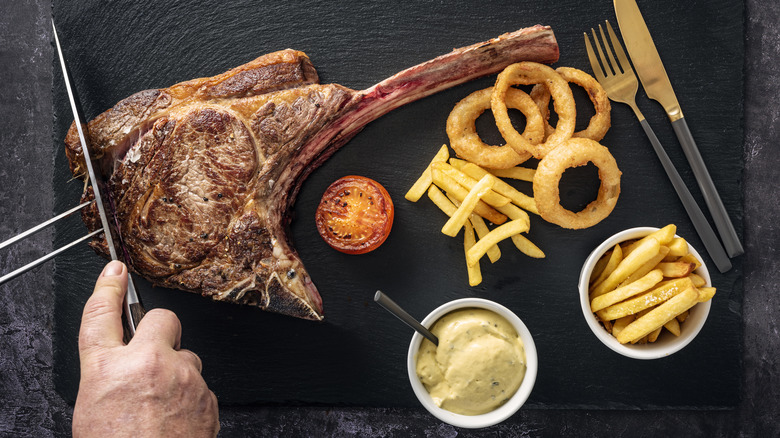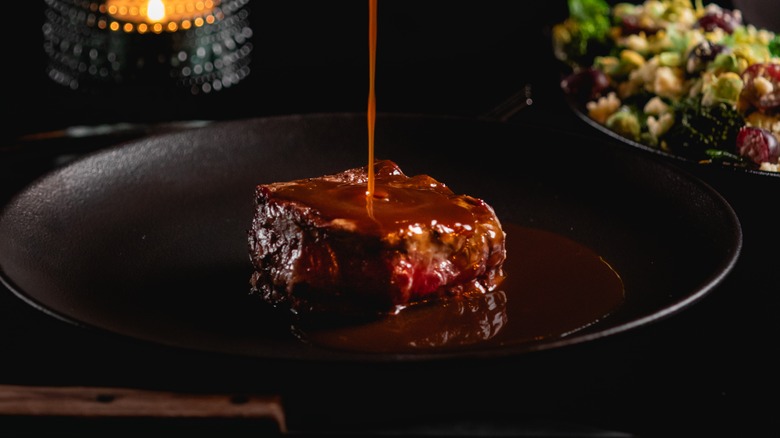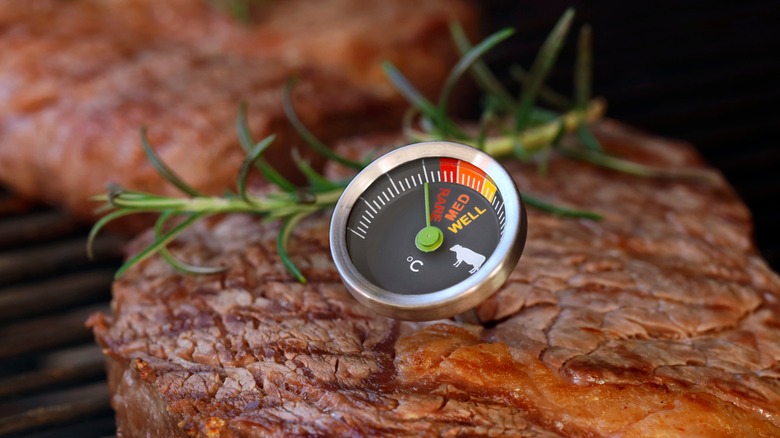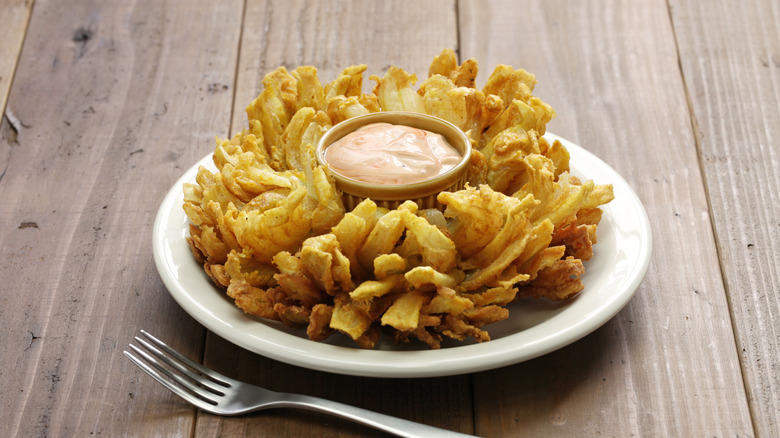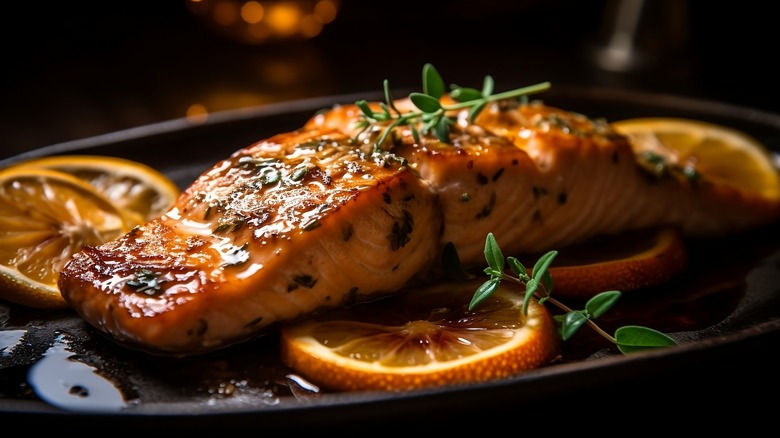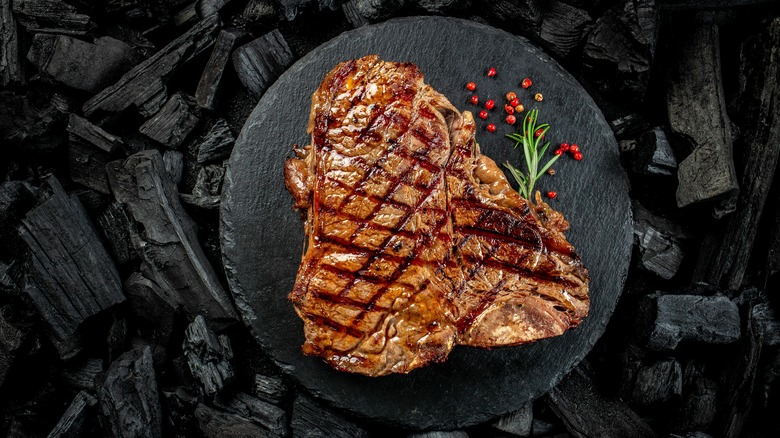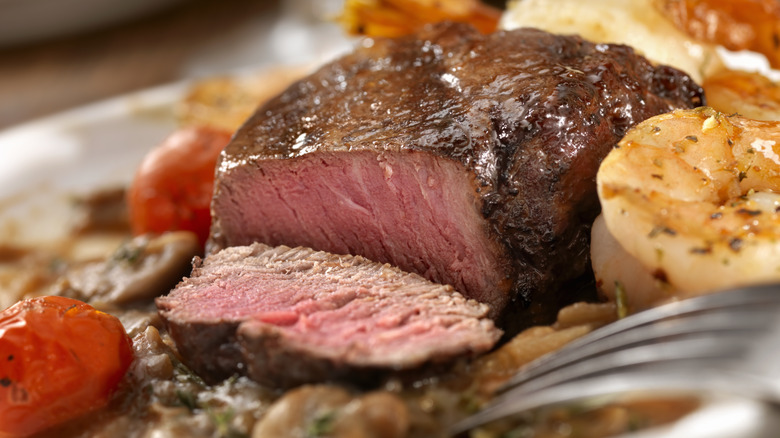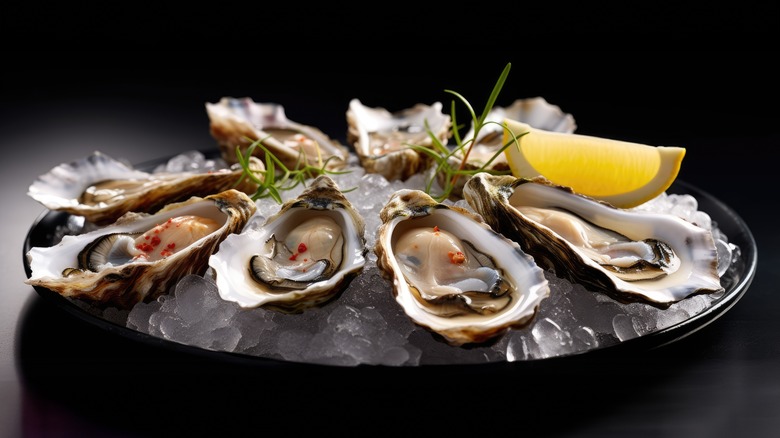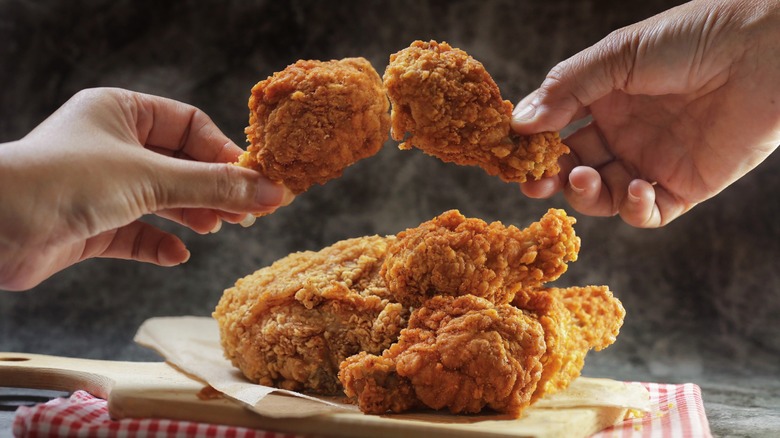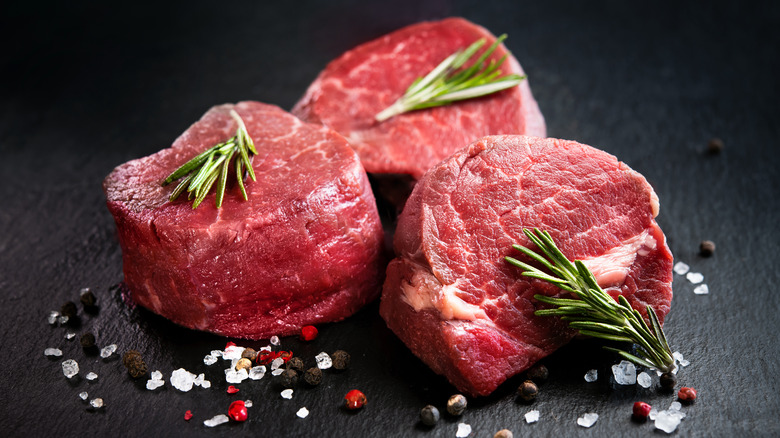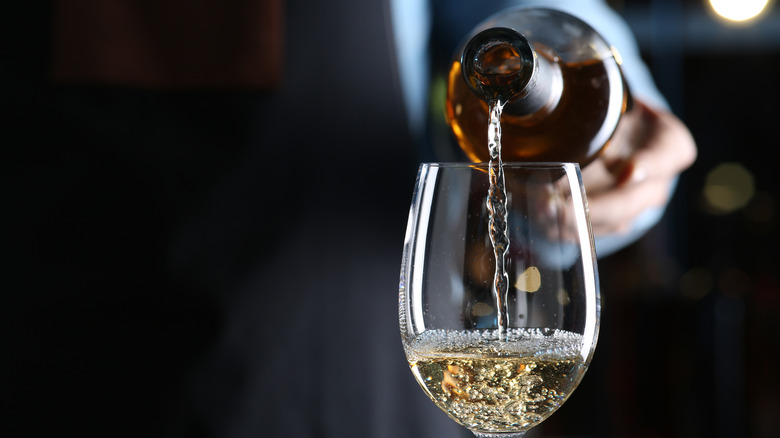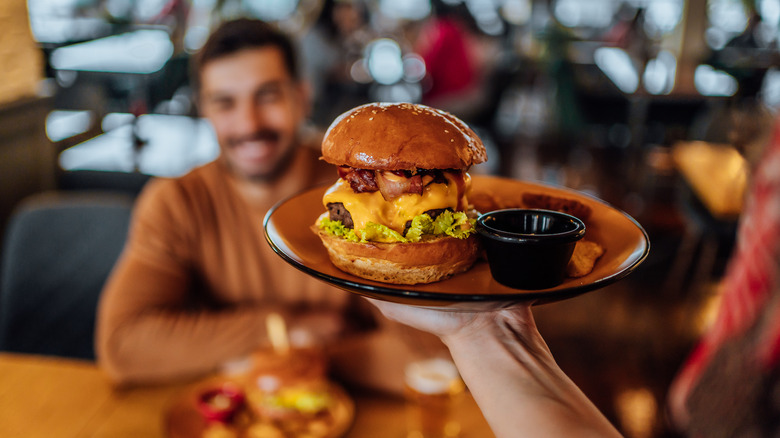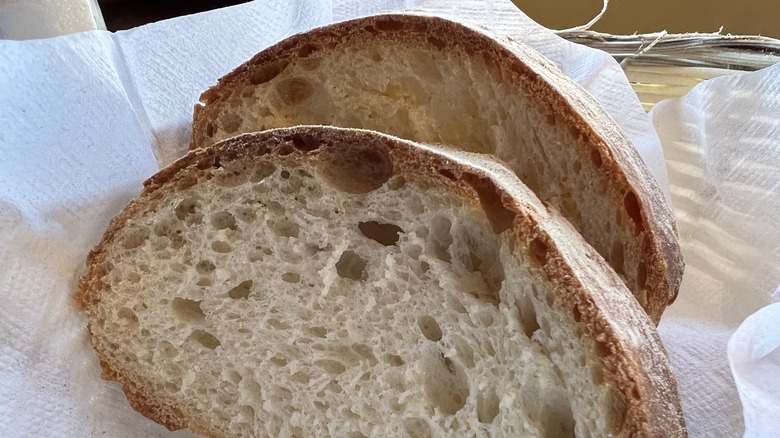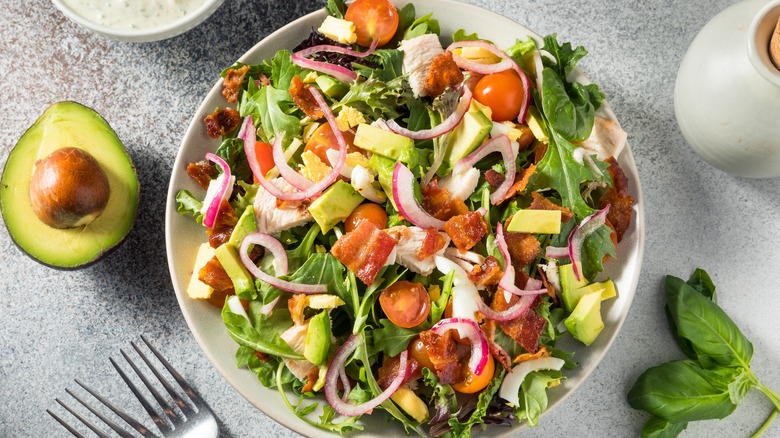13 Dishes You Might Want To Avoid Ordering At A Steakhouse
There's nowhere quite as American as a steakhouse. These meat-focused eateries started to appear in the latter half of the 19th century in the Eastern and Midwestern states and catered primarily to folks who worked in the beef industry, like ranchers, as well as travelers in need of a good meal. Although they're still highly popular in areas that have strong links to cattle production, these days you can find a steakhouse virtually anywhere in the country.
Additionally, it's not uncommon in this day and age to find that a steakhouse serves more than just steak. Although it would be sacrilege to not deliver premium cuts of beef in these restaurants, modern steakhouses now have menus that give a good amount of choice to customers with varying tastes. Incredibly, some steakhouses have even started to embrace the shift toward a more plant-based way of living, with Charley's Steak House in Florida offering a plant-based filet mignon on its menu (alongside its regular beef options, of course).
With so much choice available at these restaurants, though, there are bound to be some things that are better than others — and there are some regular steakhouse menu items that are best avoided. Whether for food safety purposes, value for money, or sheer lack of taste, we've got all the dishes you should avoid.
1. Any steak covered in steak sauce
A steakhouse option that highlights the presence of steak sauce is best avoided. Steak sauce may be a delicious condiment, but its tart, sweet, slightly smoky taste can become quickly overpowering, and end up the predominant flavor in a meal. Any dish that uses steak sauce in significant quantities, therefore, is a bit of a red flag because it could indicate that you're being served meat that isn't tasty enough to shine through on its own — as a good steak should be able to do, with minimal condiments.
It's also fairly poor etiquette to order your steak with steak sauce included, so it's best to avoid asking your server to drizzle it on for you. If you can't live without the taste of that sauce, you can always ask for a small amount on the side. We would always recommend trying your food before you add it, though; you may not need it at all. Eating in a steakhouse is also a great opportunity to try more bespoke sauces, like chimichurri or peppercorn sauce, which are likely tailor-made to boost the flavor of your steak instead of masking it.
2. A well-done Wagyu steak
Wagyu steak is highly popular, and we can get why. This Japanese beef strain is renowned for its consistent marbling, with its fat coverage making it deeply flavorful and rich. Ordering this beef well done, though, will destroy your experience. "Never order a Wagyu or American-style Wagyu cut well-done," says Salt & Fin's executive chef Eric Mickle, via Eat This, Not That. "The fat content is what makes a Wagyu a Wagyu, and by overcooking that piece of beef, you are just rendering all of that beautiful flavorful fat out.
Instead, you'll want to enjoy it as rare as you can take it. A beautiful piece of Wagyu should be cooked at a high temperature and pulled off the heat quickly to retain its fat, yet develop a flavorful crust on its outside. It's not just Wagyu you should avoid ordering well-done, though. Most steaks are way better when they're not cooked through, remaining juicier, more flavorful, and more tender. If in doubt, ask your server for what they'd recommend. Don't worry about ordering your steak medium-rare from a food safety perspective, either: If cooked by a professional chef and allowed to reach an interior temperature of 145 degrees Fahrenheit before resting, it should be fine.
3. Blooming onion
The blooming onion is a culinary marvel. Popularized by Tim Gannon, one of the co-founders of Outback Steakhouse, the appetizer has long been a staple of the steakhouse chain, with its "Bloomin' Onion" flying out of its kitchens. Many steakhouses sell their own form of blooming onion, though — and no matter where you're eating, you should skip ordering it.
"This popular appetizer features a deep-fried onion that is sliced to resemble a flower and is served with a dipping sauce, and it contains around 1,620 calories and over 120 grams of fat, making it one of the unhealthiest appetizers on any menu," states registered dietitian nutritionist, Mary Sabat, via Eat This, Not That. As the blooming onion is made and served similarly elsewhere, you'll still be getting a huge amount of calories and fat if having it in a different steakhouse. Particularly worrying is its saturated fat content, which comes in at 44 grams, roughly 220% of your daily value. Although this appetizer is designed to be shared, even eating a third of it can deliver a huge amount of a nutrient that's been linked to higher blood cholesterol levels (per the American Heart Association).
4. Grilled fish
Having a pescatarian diet can mean that you might struggle in steakhouses, which have predominantly meat-based menus. Some steak joints, however, have answered the call for more variety of their proteins by putting grilled fish dishes on their menus. We've got some bad news for fish lovers out there, though. These dishes are usually not worth your money.
The reason for this is simple: If you're dining at a steakhouse, you're dining at a place that specializes in steak, with the chefs who work there likely being pros at cooking red meat. Although they're probably able to rustle up a decent fish dish, there's a risk of these being somewhat of an afterthought. It's also important to remember that because their stock-in-trade is beef, steakhouses typically spend a good amount of time building up relationships with suppliers that provide the best meat, but their relationships with seafood suppliers may not be so robust, leading to an inferior product. When you add in the fact that steakhouses are often located inland, hundreds or even thousands of miles away from the coast, it's easy to question how good that fish will be. If you want a premium fish dish, you're far better off just heading to a seafood restaurant, where you'll get far more for your money.
5. The special
Who can resist the lure of the special in a restaurant? Unfortunately, as hard as it is to do, we would recommend you try to – because that "special" menu item might not be that exceptional. "When I go out to eat at other restaurants, I never order the specials," states Farmer's Bottega's executive chef and owner Alberto Morreale, via Reader's Digest. "Some restaurants put together their specials for the day based on what's about to expire or what they're trying to get rid of faster." This may be especially likely if the special isn't printed on any menu and is instead recommended orally by your server, which could be a sign that it's been hastily put together to work through stock.
This is troublesome in a steakhouse because, as we all know, steak tastes better when it's fresh, and no one wants to eat a piece of meat that's about to go bad. Rather than be fooled by the special, Morreale recommends asking your waiter whether there's anything that's arrived fresh at the restaurant that day. If that fails, you should stick with the steakhouse's standard menu items, as they'll likely have a plentiful fresh supply of these to work with.
6. Tenderloin
Tenderloin is one of the most popular cuts of beef out there. However, it's also one of the most overrated, and those in the know recommend avoiding it. Many chefs steer clear of ordering tenderloin, with its leanness commonly cited as an issue. "There's no flavor or fat, and the texture is horrible," says Paul Kahan, executive chef at Publican Quality Meats and Avec, per Thrillist.
Other chefs decry the tenderloin's premium status (and premium price), especially when you consider what you're getting. "It is the most expensive cut in the entire steer and tends to have no fat, poor texture, and little flavor," states celebrity chef Michael Symon. Rather than stick to the tenderloin, chef Peter Serpico recommends going for hanger steak instead. Coming from the upper belly of the cow, hanger steak is rich in flavor while still having a tender texture. Ordering hanger steak will also be kinder to your wallet, as it tends to be way cheaper than tenderloin, despite it delivering a more pleasurable dining experience. Any other cut that's higher in fat and has marbling throughout will also be more flavorful than tenderloin, so ask your server what they recommend.
7. Raw oysters
Dining in a steakhouse can be pretty luxurious, and if you're at a high-end establishment, they'll likely have some extravagant menu items, designed to prove their status. They may not always be worth the price, though. This is the case with raw oysters, which might seem like the height of culinary culture, but could leave you bent over the toilet bowl.
The problem with eating raw oysters is that they're especially prone to picking up Vibrio bacteria, a germ that builds up in their flesh due to their filtration system. Vibio causes an infection called vibriosis, a dangerous form of food poisoning that can, in extreme circumstances, lead to death (via the CDC). Although food suppliers usually make a great effort to limit instances of Vibrio bacteria in oysters, because infected shellfish show no signs of carrying the germs, it's impossible to know whether yours is dangerous to eat or not.
If that wasn't enough to put you off, you might want to consider that raw oysters might be alive the next time you eat them. Oysters are usually alive until they're shucked, and may well stay alive for a while after they've been opened, too. Kinda offputting, right?
8. Fried chicken
It's safe to assume that if you're eating at a steakhouse, you probably enjoy steak. On the off chance you don't, though, the chefs at the steak joint may well have an all-time favorite on the menu, guaranteed to cater to even the pickiest eater: Fried chicken.
So why shouldn't you order this all-time classic at a steakhouse? Unfortunately, it may just not be any good. "I will order almost anything when I go out — but never chicken because it tends to be overcooked at most restaurants," warns The Church Key's executive chef Ryan Ososky, per Reader's Digest. It's a myth that fried chicken can't be overcooked, too, and all it takes is oil set to slightly too high a temperature for it to come out dry, stringy, and overly brown.
It's also a myth that ordering chicken will be healthier than ordering steak. LongHorn Steakhouse's Parmesan Crusted Chicken dish, for instance, clocks in at 1,120 calories, with 28 grams of saturated fat (significantly more than many of its steak options), and 3,160 milligrams of sodium when ordered in a 12-oz size. That sodium quantity is way more than the maximum of 2,300 mg that you should be eating in a full day, in a single dish.
9. Filet mignon
Filet mignon has long been considered one of the classiest steaks there is, and you're unlikely to find any steakhouses that don't stock it. That's why it's pretty surprising that it's a cut of meat that you should avoid, according to chef Diana Manalang. "Yes, it is tender and juicy, but because it's so lean, it has no real flavor," Manalang stresses via Eat This, Not That. Filet mignon comes from the end of the tenderloin, which in turn comes from one of the leanest parts of a cow, and as such unless your chef is a maestro, it can end up tasteless and tough.
Regrettably, this can lead to chefs leaning on the use of sauces to moisten filet mignon and make it more palatable — but isn't the whole point of eating in a steakhouse that you should be able to enjoy the flavor of the meat itself? Skip the filet mignon, and go for the rib-eye, Manalang's favorite cut. Rib-eye is hardly a lean cut, with rich seams of fat running through its meat, but that fat gives it a hefty whack of flavor and stops you from having to jazz it up with added sauces.
10. Some styles of white wine
Any steakhouse worth its salt has an extensive, impressive wine list, with something on there to cater to every palette. If you're drifting towards the white section, though, you should choose carefully. White wine is traditionally paired with white meat and fish, but when it comes to steak, it can result in a big flavor clash. Beef pairs best with big, bold red wines that boost its juiciness and highlight its deep, savory notes. Light, dry white wines may be one of the best types for cooking with, but they're simply too crisp for steak, and have the unfortunate effect of making the meat taste flat and oddly metallic.
You're more than entitled to drink white wine with your steak, though: You just need to nail your choice. Full-bodied, fruity white wines work best here, with varieties like chenin blanc working well. Oaked chardonnays can also be a good choice, with the oak giving them a complexity and balance that complements your beef.
If you desire, you can also create a total contrast by ordering your steak with champagne, with its acidity serving as a palette cleanser. Just be sure to only do this with lean cuts, though, as it won't pair well with fatty flavors.
11. The burger
Do you want beef, but are not quite hungry enough for a full steak? Or maybe you're in the mood for something handheld? The burger at a steakhouse feels like a natural choice in these situations, and most steak joints will have their signature patty-and-bun combo. However, while a burger can feel like a steal at a steakhouse — especially in some pricier restaurants, where meat can be eye-wateringly pricey, they can still be overpriced for what they are. Your burger may be made with good-quality meat and cooked well, but if you're going to pay top dollar, you may as well get the steak, as it'll likely be better quality.
Burgers can also be unpleasantly overwhelming, particularly in food establishments where the ethos seems to be "the bigger the better." In steakhouses, burgers are often made with unwieldy, super-size patties that make the act of picking it up and eating it impossible. They're also frequently overloaded with toppings, which can make them even bigger and mask the flavor of the meat and are often served on impractical brioche rolls that fall apart in your hands. The main reason you shouldn't order them, though? They're just pretty boring.
12. The bread bowl
Bread bowls are, for many people, an essential part of a dining-out experience. In steakhouses, though — indeed, in any restaurant — they should probably be skipped. One of the reasons for this is the impact it can have on your wallet. Bread bowls usually aren't super expensive, but they can be a huge mark-up for steakhouses, jacking up the price of what is an incredibly cheap item to make. By ordering the bread bowl, you'll be spending dollars on something that may cost mere cents.
It's not only your budget that's affected, either: your appetite will be too. Bread bowls are notorious for coming before the main meal, as a way to help stave off hunger – but eat too much of it, and you'll likely not enjoy your steak when it arrives, and be too full to properly savor it. If you've been waiting months to try that fancy new steakhouse, you're not going to want to spend your time there eating their bread slices and rolls. Unfortunately (and you'll hate us for saying it), we would even recommend avoiding ordering and eating complimentary bread baskets. Think about the meal to come, and preserve your appetite.
13. The entrée salad
Steakhouses are, by their very nature, maximalist places where bigger equals better. That might not suit all appetites, though, and if you're in the mood for something lighter or some fresh vegetables, choosing a salad as an entrée might seem a smart choice. So it might shock you to hear that in steakhouses, the salads can be just as heavy as the steaks themselves. In LongHorn Steakhouse, for instance, the Crispy Buttermilk Chicken Cobb Salad is a hefty dish, providing 910 calories, 16 grams of saturated fat, and 1,170 milligrams of sodium per serving. For comparison, that's roughly the same amount of calories as a 9 oz. filet and a loaded baked potato at the restaurant.
Importantly, the salad may also be one of the least safe items on the menu. "I'd eat sushi before I ate a salad," says food safety expert Bill Marler (per Business Insider). Raw salad leaves are notorious for their potential for contamination, with the risk being even higher if the restaurant you're eating in uses pre-chopped lettuce, Marler warns. This is arguably more likely in chain steakhouses which rely on production facilities to prepare their ingredients before they even arrive.
